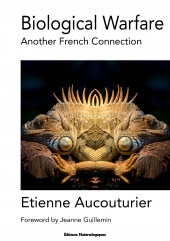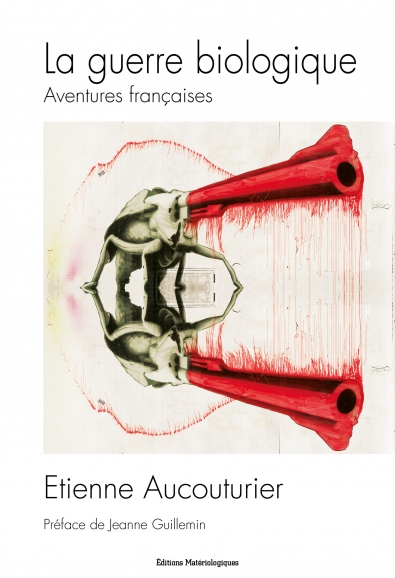No products
Prices are tax included
Product successfully added to your shopping cart
There are 0 items in your cart. There is 1 item in your cart.
News
Catalogue
Biological Warfare Another French Connection
Biological Warfare : Another French Connection, is the first book to summarize the history of France’s biological warfare programs. Highlighting the complex and always secret conceptual genesis of the notion of biological warfare in France, Etienne Aucouturier shows that the contemporary institutional separation between chemical and biological weapons converges in reality on the same project, that of providing armies with the capability to selectively target living organisms or physiology by means of surgical strikes that use poisons or pathogens.
From the invention of microbial aerosols before the First World War, to the last chemical weapons tests in the Algerian desert in the 1970s, the book documents the scientific and technical research conducted to achieve this military capability. It reports on the constant interaction between the military and civil biomedical research spheres in France during the 20th century, while at the same time retracing the history of the debates between politicians, soldiers and scientists on the subject of biological warfare, and reveals how this important aspect of the military strategy of the last three French Republics was discussed at the highest levels of state, scientific and military hierarchies. Drawing on a large number of archival documents that have subsequently become difficult to consult, Aucouturier demonstrates the way in which these secret interactions gave rise to a sort of covert agreement between France’s biomedical institutions and its military strategists.
By reversing the order of current analysis - which dissociates, in principle, chemical and biological weapons - and focusing on the military's goal of selectively targeting the living, the book also provides a dynamic and historically justified conceptual framework that permits the reader to consider, and to fear, the possible future forms that biological warfare may take.
| Authors | Etienne Aucouturier |
| Title | Biological Warfare |
| Subtitle | Another French Connection |
| Edition | First ed. in french, 2017 |
| Published | May 2020 |
| Foreword | Jeanne Guillemin |
| Translator | Etienne Aucouturier |
| ISSN | 2556-7721 |
| ISBN | 978-2-37361-239-4 |
| eISBN | 978-2-37361-240-0 |
| Support | paperback and ebook |
| EAN13 paperback | 9782373612394 |
| EAN13 ebook | 9782373612400 |
| Number of pages | 288 |
| Number of illustrations | 4 |
| Dimensions | 14,8 x 21 cm |
| Paperback price | 29 € |
| Ebook price | 19,99 € |
Abbreviations … 5
Foreword by Jeanne Guillemin (2017) … 7
Foreword by the author (2020) … 19
Introduction … 25
Definitions … 27
Structure … 31
Context and limits … 34
Chapter 1 … 41 Microbial warfare, bacteriological warfare
The art of artificial epidemics … 41
Microbial warfare and bacteriological warfare … 51
WW1 … 53
Chapter 2 … 61 Gestation and birth of the French CBW programs
Trillat’s research : artificial clouds and biological warfare … 62
Military applications … 65
Chapter 3 … 73 Inventing the French CBW program
The Poudrerie du Bouchet … 75
The German threat … 82
Chapter 4 … 91 What happened to the French CBW program under Nazi occupation ?
The SIPN and the Omnium des produits azotiques … 92
The “Débacle” and the Station d’Essais du Bouchet … 94
Biological warfare in (yet another) population-level sense … 100
Chapter 5 … 105 The Libération and the understanding of Biological Warfare in France
Physician Lieutenant-Colonel Jude’s conference … 106
The resumption and the Medical Defence Board against Modern Warfare … 109
Institut Pasteur and the Civilian-Military Commission on CBW … 111
Chapter 6 … 121 German know-how and the “unbearable constraint”
The “unbearable constraint” to think as an aggressor … 124
Aerosols and clouds : “making the rain and the sunshine” … 133
A vaccine against radioactivity ? … 136
Chapter 7 … 139 Towards biochemical defence
The temporary end of “bacteriological” warfare … 142
A renewed trust in Institut Pasteur … 150
Chapter 8 … 155 Special weapons : The Commission on Chemical and Bacteriological Studies and Experiments (CEECB)
Mass destruction and ecological warfare … 160
Statistics and populations … 164
Chapter 9 … 171 Mass destruction and chain reaction
Producing well-defined results in space and time … 172
Decay Weapons … 181
Mechanical vectors : fuses and shells … 183
Chapter 10 … 191 Towards rearmament : 1959-1965
Some collaborations with the USA and the Netherlands … 192
A slow recovery … 199
A focus on incapacitants ? … 206
Chapter 11 … 211 Reorganizations and privatizations
An unprecedented recourse to the private sector … 213
Small and large animals … 217
Chapter 12 … 225 The Sahara trials and the Sodeteg
Aromas, spices and B2-Namous … 226
The Sodeteg sheep … 230
Lamppost and marjoram … 236
Chapter 13 … 245 State secrecy and the law
What happened to the French biological warfare program after 1972 ? … 258
Dealing with the law : offense and prophylaxis … 260
The disturbing fate of Sodeteg … 260
Conclusion … 273
Index … 277



